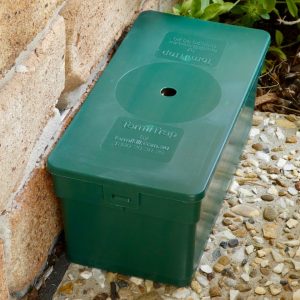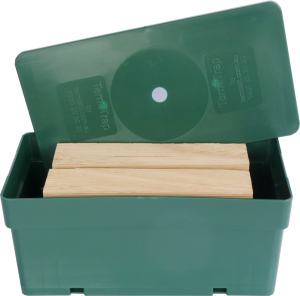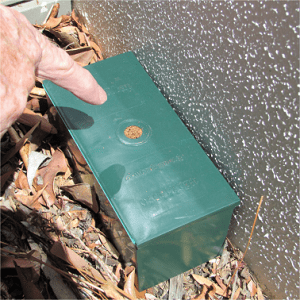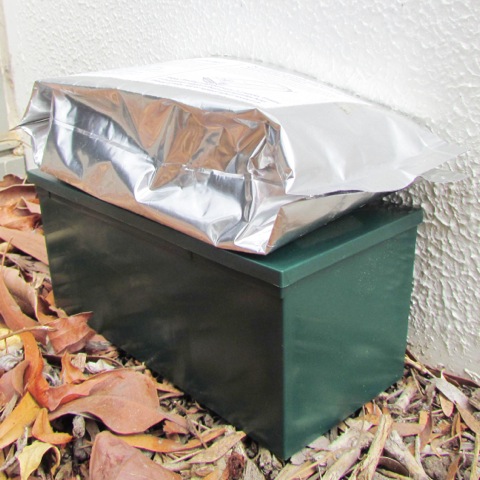Let’s Keep it that Way by Using One of Our DIY Termite Treatments

But not having found termites is not quite the same as not finding them after a thorough termite inspection of your home.
So get a torch and go tap around all your skirting boards, window and door frames, have a lookup in the roof for any telltale mud in the joints of the roofing timbers and, if you have a suspended wooden floor go under to see if there are any mud tunnels going up the piers, stumps or foundation walls to the bearers and joists. Full details on the inspection are here.
Still No Live Termites?
The very best thing to do now is to place some TermiTraps around your home and sheds, etc. TermiTraps contain timbers that termites find attractive and it is these decoy timbers that entice termite scouts into the Termite Monitors.
Once the termites build a connecting tunnel to the TermiTrap, they seal up the hole in the lid so you’ll know it is time to begin baiting using the Colony Killer Termite Bait.
Coptos and Schedos, the two termites that do almost all the damage to Aussie buildings, nest in the soil or in hollow trees OUTSIDE buildings. So, if there are no termites inside your home and the termites that do almost all the damage to homes build their nests outside, it sure makes good sense to encircle your home with TermiTraps to stop them getting from where they are to where you don’t want them to be.
As Coptos and Schedos are pretty much spread over the whole of continental Australia, your risk is real — and Colony Killer Termite Bait is designed primarily to deal with especially these two Termites.
Since about 2001, mainstream termite treatment companies have been installing monitoring systems around homes as a simple but very effective method of reducing termites getting into houses/buildings because it works! As a DIYer, you can do this job as well — and cheaper.
There are Essentially Two Types of Termite Monitors
- those buried in the ground, and
- those placed above ground level.
Scouts looking for a new food source are highly likely to discover attractive timber in semi-sealed containers thoughtfully placed at 3-metre intervals around where they are snooping.
What is even more probable: a monitor/trap/station/aggregation device placed above soil level will get their attention sooner. Scientific trials have confirmed this.
Termites mostly find in-ground monitors by burrowing through the (usually) upper 100mm of soil until they pick up the traces of carbon dioxide emanating from decaying wood and they turn ‘upstream’ toward the source.
The effort required to do this is much greater than sending scouts up above the surface where they can traverse greater distances in a shorter time.
Placing the TermiTrap termite monitor on concrete paths against walls with openings over the gap in the expansion joint means the scouts moving along the joint are highly likely to encounter a station.
Or, placing a termite monitor over gaps between pavers or just anywhere in a garden puts it in the path of those scouts who begin searching above ground level on warm and humid summer evenings.
Why Specifically are On-Ground Termite Monitors Any Better at Intercepting Scouts?
One answer is that it takes less energy and, more distance can be covered by scouting above the soil. But the really incontrovertible fact is that every piece of timber that has ever been attacked above the foundations of a building has been found because termite scouts have left the ground to find it. Above ground, TermiTraps is up where the scouts are ‘looking’
The only place you wouldn’t use an on-ground station is on a lawn. This also means the time is taken and the energy cost to us humans is also much less for the installation procedure. No digging to fight roots and rocks.

This is a Termite Monitor, the TermiTrap.
The UV-protected plastic box is open at the bottom, contains attractive-to-termites timber and there is no digging to place them at about 3-metre intervals around your buildings.

This Termite Monitor has been placed in a garden against a wall.
The hole in the lid has been filled by the termites with their ‘mud’ mixture to prevent loss of humidity and to exclude ants.
The blocked hole is the signal to tell you Termite has arrived and to begin the baiting process.

The underside of the Colony Killer Termite Bait pouch is adhesive to stick it to the lid allowing termites direct access to the bait.
When baiting is completed, the Termite Monitor can be washed out, new timber added and replaced on duty in case another colony develops nearby.

